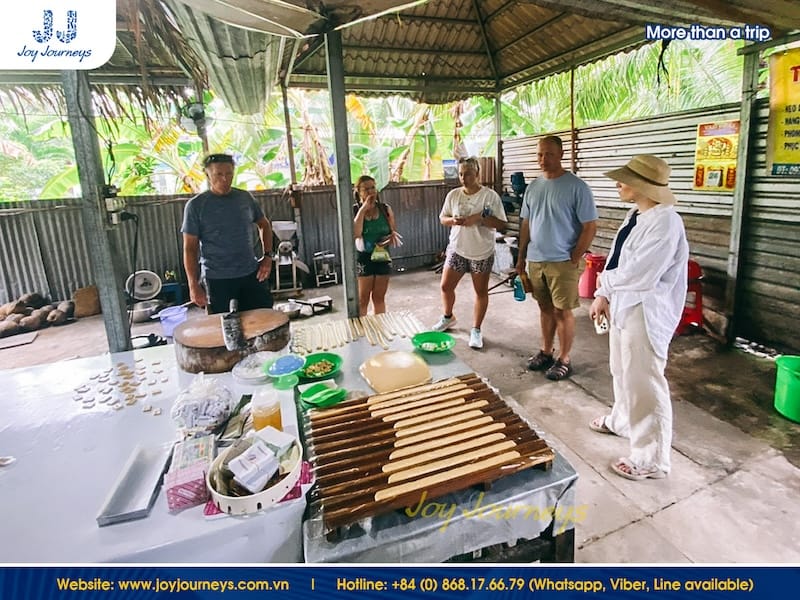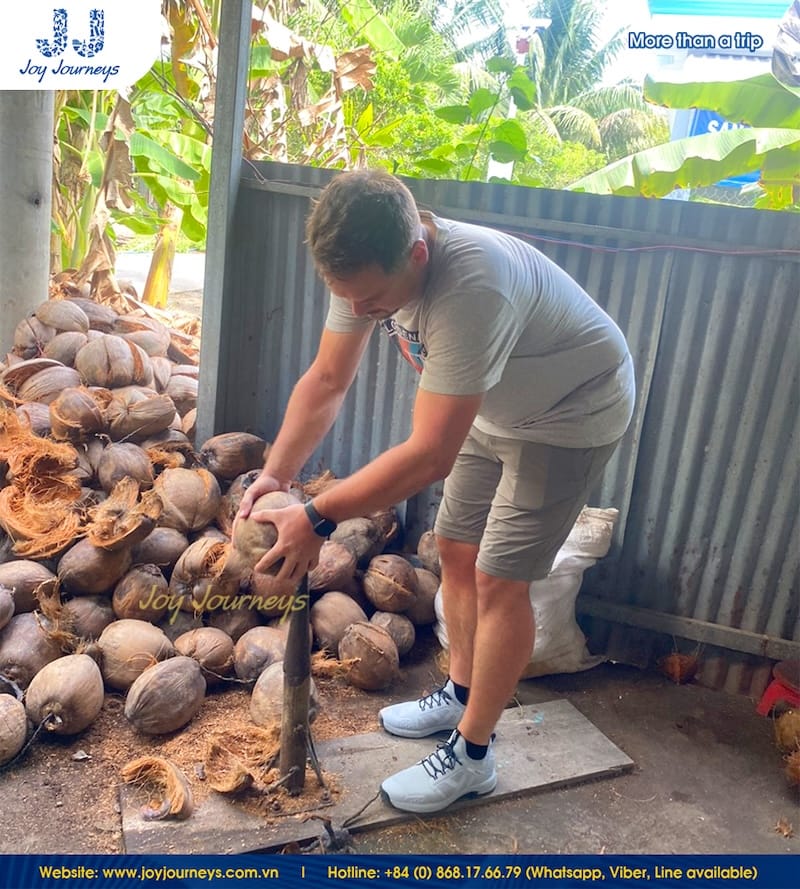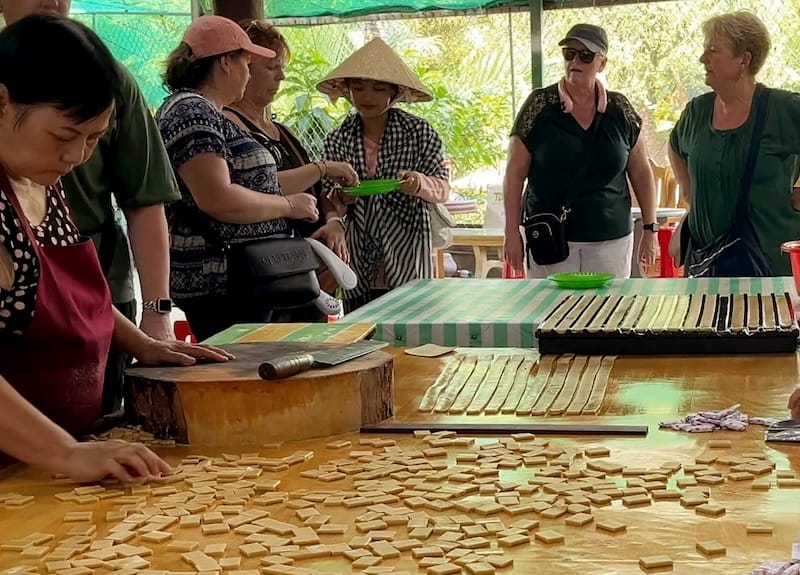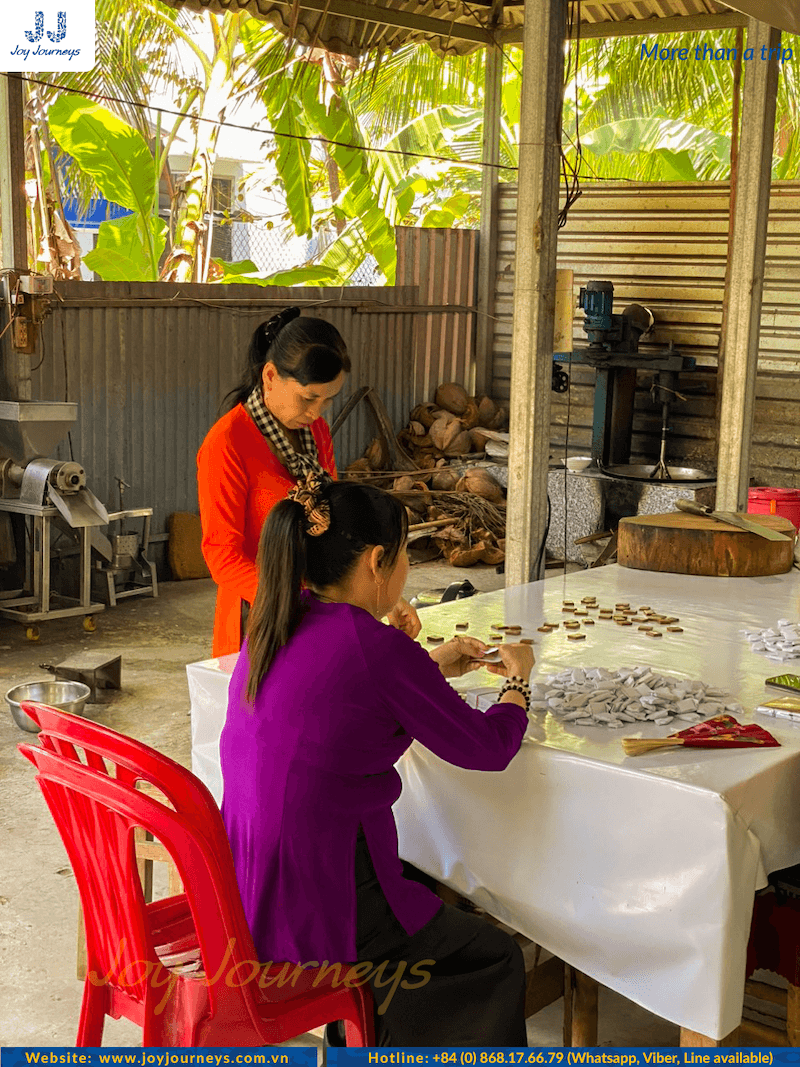Vietnam coconut candy represents one of the most beloved and iconic sweets in Vietnamese cuisine, embodying the rich agricultural heritage of the Mekong Delta region. This chewy, aromatic confection has captivated both locals and international visitors for generations, serving as a perfect introduction to the unique flavors and traditional craftsmanship that define Vietnamese culinary culture.
From its humble origins in Ben Tre province to its current status as a must-try delicacy, Vietnam coconut candy offers a sweet journey through the heart of the country’s “coconut kingdom.”

Contents
What is Vietnam Coconut Candy?
Coconut candy, known locally as “kẹo dừa,” is a traditional Vietnamese confection characterized by its distinctive chewy texture, rich coconut flavor, and golden-brown appearance. This beloved sweet treat combines the natural sweetness of fresh coconut milk with the subtle complexity of malt syrup, creating a harmonious balance that has made it a signature product of the Mekong Delta region.
The candy’s texture is uniquely satisfying – firm enough to hold its shape yet soft enough to yield pleasantly when bitten. Its flavor profile showcases the pure essence of coconut, enhanced by the caramelized notes that develop during the cooking process. Unlike many modern confections, traditional coconut candy maintains its artisanal character through time-honored production methods that have been passed down through generations.
Coconut candy Ben Tre has become synonymous with quality and authenticity, as Ben Tre province produces over 70% of Vietnam’s coconuts and houses more than 180 coconut candy production facilities. This region, often called the “land of coconuts,” provides the ideal conditions for both coconut cultivation and candy production, making it the undisputed center of Vietnam’s coconut candy industry.
The Making of Coconut Candy: A Traditional Craft
Understanding how to make coconut candy reveals the intricate balance of skill, timing, and quality ingredients that define this traditional craft. The process, while appearing simple, requires considerable expertise to achieve the perfect texture and flavor that characterizes authentic Mekong Delta coconut candy.
Ingredients of Coconut Candy Ben Tre
The beauty of Vietnam coconut candy lies in its simplicity, requiring only three primary ingredients:
- Fresh coconut milk (73%): Extracted from mature coconuts, preferably from Siamese coconuts known for their rich, creamy texture and natural sweetness.
- Granulated sugar (20%): Provides sweetness and contributes to the candy’s characteristic caramelization.
- Malt syrup (7%): Made from fermented glutinous rice, adding depth of flavor and helping achieve the proper consistency.
Additional ingredients may include natural flavorings such as durian, pandan leaves, cocoa, or peanuts, depending on the desired variety. The quality of these ingredients, particularly the freshness of the coconut milk, directly impacts the final product’s taste and texture.

Step-by-Step Process
The coconut candy recipe follows a time-tested methodology that has remained largely unchanged for decades:
- Preparation Phase: Artisans begin by carefully selecting high-quality coconuts and extracting fresh milk using traditional methods. The coconuts must be at optimal ripeness to ensure the creamiest texture and richest flavor.
- Mixing: The coconut milk is combined with malt syrup and any desired flavorings in precise proportions. This mixture forms the foundation of the candy and must be thoroughly blended to ensure uniform flavor distribution.
- Cooking: The mixture is heated in large pans over controlled heat, requiring constant stirring to prevent burning and ensure even cooking. Traditionally, this step was performed entirely by hand, but modern facilities now use mechanical stirrers while maintaining careful temperature control.
- Concentration: As the mixture cooks, it gradually thickens and changes color from white to golden brown. This process typically takes 45-60 minutes and requires constant attention to achieve the proper consistency.
- Molding: Once the mixture reaches the correct thickness, it’s poured into greased molds to set its shape. The candy remains in these molds for approximately two hours to cool and achieve the desired firmness.
- Cutting and Wrapping: After cooling, the candy is cut into individual pieces, often by hand or specialized machines. Each piece is then wrapped in rice paper to prevent moisture absorption and maintain freshness.
Variations
Vietnamese candy makers have developed numerous variations of the classic recipe to cater to different tastes and preferences:
- Durian coconut candy: Incorporates the distinctive flavor of durian fruit for those who appreciate this delicacy.
- Pandan coconut candy: Features the subtle, sweet flavor and natural green color of pandan leaves.
- Peanut coconut candy: Includes crushed roasted peanuts for added texture and nutty flavor.
- Chocolate coconut candy: Combines cocoa with traditional ingredients for a modern twist.
- Taro coconut candy: Features the mild, sweet flavor and purple color of taro root.

Cultural Significance of Traditional Coconut Candy
Vietnam coconut candy holds deep cultural significance that extends far beyond its role as a simple confection. In Vietnamese society, coconut candy serves as a symbol of hospitality, tradition, and regional pride, particularly in the Mekong Delta region where it originated.
The candy plays an important role in Vietnamese gift-giving culture, often presented to visitors as a gesture of welcome and friendship. During traditional holidays such as Tet (Vietnamese New Year), families frequently exchange boxes of coconut candy as symbols of sweetness and prosperity for the coming year. The practice of offering mekong delta food specialties like coconut candy to guests reflects the Vietnamese values of generosity and cultural sharing.
For many families in Ben Tre and surrounding provinces, coconut candy production represents a vital source of income and a means of preserving traditional craftsmanship. The industry supports thousands of workers across the region, from coconut farmers to candy makers, packaging workers, and distributors. This economic impact has helped maintain rural communities and preserve traditional skills that might otherwise be lost to modernization.
The candy also serves as an ambassador for Vietnam food culture, introducing international visitors to the unique flavors and artisanal traditions of the Mekong Delta. Many tourists consider purchasing authentic coconut candy an essential part of their Vietnamese travel experience, helping to spread awareness of the country’s culinary heritage worldwide.
Where to Buy Coconut Candy
Finding authentic best coconut candy Vietnam requires knowing where to look and which brands to trust. The quality and authenticity of coconut candy can vary significantly depending on the source and production methods used.
Buying Coconut Candy in Vietnam
Ben Tre Province: As the birthplace of coconut candy, Ben Tre offers the most authentic and diverse selection. Visitors can purchase directly from production facilities, local markets, or specialized shops throughout the province. Popular brands include:
- Thanh Long Coconut Candy: Established in 1970, this pioneering brand offers traditional flavors and modern variations, with products exported to the USA and Australia.
- Ba Hai To Coconut Candy: Known for defending their brand in international court battles, this company has over 40 years of experience and exports to multiple Asian countries.
- Hong Van Coconut Candy: Offers eco-tourism experiences where visitors can observe the production process while enjoying fresh candy.
Ho Chi Minh City: Major markets and specialty food stores carry various brands of coconut candy, though selection may be more limited than in Ben Tre. Ben Thanh Market and other tourist-oriented locations typically stock popular brands.
Can Tho and My Tho: These Mekong Delta cities offer good selections of local coconut candy brands, often at competitive prices due to their proximity to production centers.

Buying best Coconut Candy Vietnam Online
For international customers seeking authentic coconut sweets, several reputable online retailers offer genuine Vietnamese coconut candy:
- Chus.vn: Features authentic Ben Tre coconut candy from established producers like Dat Phu, with detailed ingredient information and quality guarantees.
- Vietnamese specialty food websites: Many sites specializing in Vietnamese products offer coconut candy with international shipping options.
- Amazon and other major platforms: While selection may be limited, some authentic brands are available through these channels.
When purchasing online, look for products that specify their origin in Ben Tre and list natural ingredients without artificial preservatives or excessive additives.
Watch How to Make Coconut Candy with Joy Journeys
Joy Journeys offers immersive Mekong Delta coconut candy experiences that allow visitors to witness the traditional production process firsthand. Their “Authentic ‘Less-Touristy’ Mekong Delta Ben Tre 1-Day Tour” includes visits to local coconut candy workshops where guests can observe artisans at work and even participate in the candy-making process.
During these experiences, visitors learn about the cultural significance of coconut cultivation in the region and gain insights into how local families have built sustainable livelihoods around coconut processing. The tour includes opportunities to taste fresh coconut candy directly from the production line and purchase authentic products to take home.
Joy Journeys’ commitment to sustainable tourism ensures that these visits benefit local communities while providing visitors with genuine cultural experiences. Their knowledgeable guides explain the historical development of the coconut candy industry and its importance to the regional economy.

FAQs
What is the shelf life of coconut candy?
Properly stored Vietnam coconut candy typically has a shelf life of 6-12 months. The exact duration depends on storage conditions, packaging quality, and specific ingredients used. Candy wrapped in rice paper and stored in airtight containers maintains freshness longer than unwrapped varieties.
How should coconut candy be stored?
Store coconut candy in a cool, dry place away from direct sunlight and moisture. Airtight containers or sealed packages help prevent the candy from becoming sticky or hard. Refrigeration is not necessary but can extend shelf life in humid climates. Avoid storing in areas with temperature fluctuations.
Is coconut candy gluten-free/vegan/keto-friendly?
Traditional coconut candy is naturally gluten-free and vegan, containing only coconut milk, sugar, and malt syrup. However, some varieties may include milk powder or other non-vegan ingredients, so check labels carefully. For those following keto coconut candy diets, traditional versions are high in sugar and not keto-friendly, though some producers now offer sugar-free alternatives using natural sweeteners.
Taste the sweetness of the Mekong Delta! Experience authentic Vietnam coconut candy on your next visit to Vietnam with Joy Journeys’ immersive tours, or discover this traditional treat through reputable online retailers. Visit joyjourneys.com.vn to book your authentic Mekong Delta experience and witness the traditional candy-making process in the heart of Vietnam’s coconut kingdom.



Related Posts
Saigon’s “Flower Market Replica”: Where To Find Them
Ho Chi Minh City’s floral charm is not limited to its bustling wholesale markets. Imagine wandering through a place where vibrant petals, fragrant blooms, and the spirit of traditional Vietnamese markets come alive—without the overwhelming crowds. A flower market replica captures that magic, blending the beauty of fresh flowers with the charm of a curated, […]
Is it Safe to Travel to Vietnam Right Now? A Complete 2025 Guide
Vietnam has emerged as one of Southeast Asia’s most captivating destinations, drawing millions of visitors annually with its rich culture, stunning landscapes, and incredible cuisine. However, many travelers still ask: Is it safe to travel to Vietnam right now? This comprehensive guide provides you with everything you need to know about Vietnam travel safety in […]
Ho Chi Minh Cu Chi Tunnels Tour: The Ultimate Guide
The Cu Chi Tunnels stand as one of Vietnam’s most remarkable historical sites, offering visitors a profound glimpse into the ingenuity and resilience displayed during the Vietnam War. For travelers, a Ho Chi Minh Cu Chi tunnels tour represents an essential experience that combines education, adventure, and deep cultural understanding. This comprehensive guide will help […]